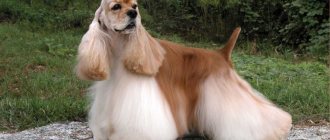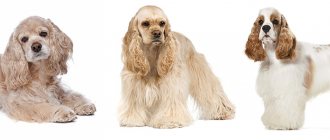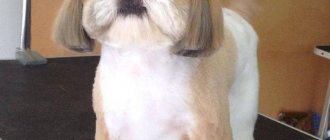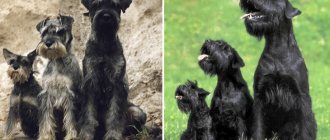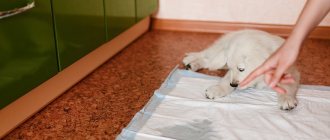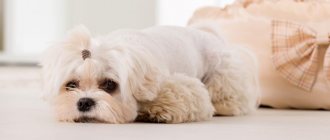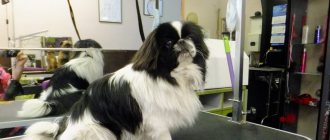Home / Breeds / Dog grooming / / Russian Spaniel
The first spaniels began to appear in Russia from the end of the 19th century, and the Russian variety of the spaniel developed by the middle of the 20th century. Thus, the spaniel is one of the youngest breeds of Russian dogs. The breed gained great popularity in the 90s; the rise in popularity of the Russian Spaniel was caused by the start of the annual Moscow Dog Show. Initially, the spaniel was a hunting dog, its task was mainly to find and bring prey, however, it can also successfully act as a pointer.
General requirements for cutting spaniels
Grooming is a must to maintain your dog's appearance and comfort. Here we are not even talking about participation in competitions or exhibitions, but even about maintaining good health and well-being of the dog.
Grooming a spaniel on a professional groomer table
There are special options for each breed. Even the haircut of a Russian spaniel may differ from that of a cocker spaniel, not to mention fashion trends.
For your information! You can perform cosmetic procedures in a special salon or limit yourself to minimal care at home.
The main thing is to remember a few rules on how to trim a cocker spaniel at home:
- The fur on the face, head and neck should be kept short;
- on the shoulders and back the hair is left almost the entire length, only light trimming is acceptable;
- the longest hair should be on the ears, belly and paws;
- excess curl should be removed, but beautiful curls will always remain on the ears, like the calling card of the breed.
Nature dictates that this breed grows fur in a terrible condition. It is very thick, but shiny. You definitely need to take proper care of it and try to add shine and maintain perfect shape. In this case, the dog will look great. This is why many owners are wondering how to cut a spaniel's hair at home.
Grooming, haircut, trimming spaniel. Haircut diagram and photo, spaniel puppy haircut.
Well-groomed spaniels are very beautiful dogs with luxurious coats. This pet’s silk outfit is not only a gift of fate, but also the result of the efforts of the owner and groomer. Remember this. In order for your beloved spaniel, no matter whether it is a cocker, a hunting dog or a toy, to remain healthy and beautiful, you need to regularly care for it. Caring for your pet's coat is a moment of relaxation and a way to express your attention and care to the dog.
Hygienic grooming | grooming or cutting a spaniel at home
- Bathe your dog as it gets dirty - once every 1-3 weeks, using a specialized shampoo for flowing hair and conditioner. Spaniels love to swim, that's great!
- After bathing, blot the spaniel's coat with a terry towel, wrap the dog in it for a few minutes and then dry it with a hairdryer, carefully combing the coat with a slicker brush and a metal comb.
- Trim and sharpen your pet's nails every 4-6 weeks using a nail clipper; Remove excess hair from paw pads to maintain healthy foot structure.
- Clean your ears with a special product
- Comb the dog's fur with a rubber mitt and a slicker brush, checking your work with a comb afterward, getting rid of shedding hairs and dandruff. Remove tangles in a timely manner! If the fur is matted into felt boots, it is no longer possible to comb it without discomfort for the dog, then you will have to cut out the tangles and the dog’s hair will be ruined!
- Check your dog's teeth every week and brush them. This is not difficult if you teach your spaniel this procedure every day after a walk and washing his paws. Take a special or children's toothbrush, specialized toothpaste and try it.
- Take your dog to the groomers more often - once every 2-3 months!
Spaniel puppy grooming
Caring for any dog, especially a spaniel, i.e. To get used to grooming, you need to start at an early age. Why? Yes, because, like any child, a puppy must learn. He learns calmly and even with pleasure, treats bathing, is not afraid of the noise of water, hair dryer, comb and stands calmly on the groomer's table, enjoying it. But in fact, it should be pleasant for the dog. When they bathe her, they massage her, stroke her, caress her. And when they comb it, they gently scratch it behind the ear, along the back and rump. Those who have a dog know how much our pets love it. So make grooming a pleasure for your dog. Can you? The breeder begins grooming the puppy at 45 days of age, and you just need to continue.
- Start by bathing your cockerel in water at room temperature. If the baby is afraid of the bath (large space), then place him in the basin and quietly water him with warm water from a ladle or shower with low water pressure.
- After bathing, wrap your baby in a terry towel and gently blot the fur while talking affectionately to the dog. A warm bath will relax anyone so much that they will fall asleep.
- Then you carefully turn on the hair dryer and direct warm air onto the dog’s back and butt and dry the fur, combing it with a slicker brush with droplets on the tips of the teeth so that it does not hurt.
Haircut and trimming of a spaniel - diagrams, descriptions, photos
Long, shiny hair is the main decoration of the spaniel; it is constantly growing, so it is regularly looked after, combed, cut, trimmed so that the pet looks neat and well-groomed. Of course, even for the 4 most common varieties of spaniels listed above, the hairstyle requirements differ significantly. However, there are also common features. This is smooth, close-fitting, shorter hair on the neck, back, and muzzle. Decorating wool, feathering along the bottom of the body and the inside of the paws. Spaniel wool is thick, soft, similar to silk yarn. For all spaniels, it is necessary to trim the hair on the paws, in the interdigital space and pay special attention to the fringe areas, in the armpit and groin folds, and ears, where moisture, dirt most quickly collects and tangles form.
Types of spaniels and their distinctive features
Depending on the dog's breed, groomers recommend different approaches. In particular, the haircut of an American Cocker Spaniel will always be different from that of a Russian.
Features of a haircut for a particular breed:
- The English Cocker is a breed with strict standards. In this case, it is unacceptable to cut the spaniel with a clipper; you must definitely get into the hands of a talented groomer;
- The Springer is a graceful, large dog. She has short hair almost everywhere, with only curls left on her ears. Specialists can show their imagination here;
- The American breed is distinguished by the thickest and most beautiful coat. It practically does not curl along the body, falling down;
- Many people wonder how to cut a Russian spaniel. Animals can vary greatly within the breed, so you can safely focus on your taste;
- The Cavalier King Charles has an almost straight, slightly wavy and thick coat. The dogs are left fluffy, but their fur is tidied up.
There are many other varieties, but these are the most popular.
Note! Spaniel grooming is considered one of the most difficult precisely because each breed has its own strict standards.
What tools will you need?
To groom your pet you will need the following tool:
- hair dryer;
- tangle cutter;
- a special clipper with attachments (the clipper is not suitable for humans, since dogs have a different hair structure);
- straight scissors;
- rounded scissors for decorating paws;
- thinning scissors;
- comb-furminator, trimming knife or fingertips for stripping the back;
- wide-toothed comb;
- brush.
A grooming table is quite expensive, but if you plan to groom your pet often, this purchase makes sense. The table has a rubberized platform on which the dog will not slip, the height is adjustable to suit your height, and a rod with a lock securely fixes the furry client and prevents escapes.
Types of haircuts and their features
It is impossible to definitively answer the question of how to cut a spaniel's hair. These dogs can be very different, with different standards. In addition, many people are allowed to show their imagination, and there is a wide range of haircut models.
Original Cocker Spaniel hairstyles
For exhibitions there is a single procedure that is universal for each breed. Stages of its creation:
- Brush your pet with a stiff brush.
- Comb the body with a fine comb.
- Use a sparse comb to go through the long, wavy coat.
- Use a trimmer to trim the back and sides.
- Using a clipper, trim the ears on all sides to the desired length.
- Remove hair between toes and in the groin area.
- Bathe the dog and dry it.
Important! If you need to show your pet at competitions, then you need to contact a professional master who knows all the nuances of working with wool.
For American Spaniel
This dog is distinguished by its appearance. The head is cut very short with a clipper. The fur on the back and sides is not touched; it should lie tightly. The hair on the paws and lower sides is simply arranged so that it forms a kind of skirt.
How to cut your own hair?
- First of all, you need to comb the dog’s fur with a brush, and if there are tangles, take them apart or cut them off.
- The cocker is washed and combed with a wide-toothed comb, after which the pet is thoroughly dried with a towel, dried with a hairdryer and its coat is carefully combed again.
- The crest or protruding hairs on the scalp are plucked by hand.
- The ears, outside and inside, are cut as short as possible at the top by 2/3 of the length. To do this, you can use a clipper with attachment No. 10. At the bottom of the ears, the hair is trimmed with thinning scissors, and you need to trim it so as to give the animal’s ears a teardrop shape.
- The cheekbones and muzzle are also cut short with a clipper. In this case, you need to act especially carefully in the lip area so as not to injure your pet or cut off its whiskers. If you are not sure that you will be able to do this neatly and evenly using a machine, then you can use thinning scissors.
- The hair on the chin, throat and sides of the neck is cut downwards.
- The sides of the chest are cut short with a clipper according to the growth of the fur. In this case, a triangular area with long hair should be left in the upper part of the chest.
- On the sides of the body and on the stomach, the hair is trimmed with thinning scissors or shortened to the desired length.
- The undercoat on the back is plucked by hand or using a trimming knife.
- The croup is trimmed.
- The lower part of the limbs is processed using ordinary scissors. The hair between the toes and along the contour of the paws is trimmed.
- On the hind legs, the hair remains long from the hip to the hock; below it it should be shortened.
- On the front legs, the hair should be cut short on the front and sides. There are beautiful fringes at the back.
- The tail is short processed with a machine.
- In the area of the anus, a diamond-shaped area is cut off with thinning scissors and smoothing is done from the base of the tail to the ischial tuberosity.
IMPORTANT!
The transitions between short and long hair should be smooth, not abrupt.
It is also very important to remember that the hair on the back, back of the neck and sides of the Cocker cannot be cut or, especially, shaved. Ideally, you need to pluck it by hand, but if the pet does not participate in exhibitions, then you can treat it with a trimming knife.
Cut it yourself or leave it to a professional
There are several factors that are necessary for a successful haircut. Every professional groomer takes them into account.
Spaniel after a hygienic haircut
The owner must evaluate his capabilities before starting work with his own hands:
- hygiene and sanitation must be carefully observed;
- you need professional equipment: from simple tools, scissors and combs to clippers and trimmers;
- it is necessary to ensure calm behavior of the animal;
- You will need to find a huge amount of time for each haircut.
Important! Some owners prefer to cut their hair themselves, but it is very important to prepare properly. The workplace must be properly decorated.
What you need for a haircut
To groom a cocker spaniel, you need to stock up on a certain set of tools and equipment:
- table, preferably with adjustable height;
- dog clipper with various attachments;
- straight and thinning scissors;
- trimming knife;
- combing brush;
- combs (with rare and frequent teeth);
- hair dryer for drying wool after bathing;
- rubber mat for the cocker spaniel's comfort during the procedure.
If your pet tries to run away or spins around, you can use a leash, but it is better not to do this. If the fidget is too excited, you should postpone the haircut session. Otherwise, there is a danger of injuring the animal.
How to cut a spaniel's hair at home with scissors
The haircut tutorial is very simple. It is important to prepare well, collect a set of necessary tools and equipment, and undergo the necessary training.
King Charles on a walk after getting a haircut
Important! If this is a show dog, then it is best to leave it in the hands of a professional. You can practice grooming with your pet, because in this case you won’t have to pay for a mistake.
How to trim an English Cocker Spaniel at home
First of all, you need to bathe the dog, and then begin to comb it thoroughly.
Note! Long hair remains at the bottom. That is why it is important to comb everything thoroughly there and sort out the tangles. You can reduce the length of your hair with scissors.
The muzzle is cut with a clipper very carefully with short movements. Then you definitely need to treat each leg and ears, shortening the hairs. Finally, trimming of the croup and body is carried out at the end. All that remains is to dry and lay the dog down.
Grooming an American Cocker Spaniel at home
Grooming an American Cocker's hair is not easy. This is one of the funniest dogs.
Note! The breed is very curly and attractive, but it is important to pay attention to every hair.
Almost only the muzzle is trimmed here, as well as the front legs a little. All other hair is carefully thinned and styled. Some skills are required, but in general the mistakes are not fatal.
How to trim a Russian spaniel at home
Many people decide not to cut their Russian Spaniel's hair at all. Often this is the right decision. For a pet, hygienic care is sufficient.
It is important to always trim the hair in the groin, as well as care for the paws and ears.
If you decide to get a haircut, you need to arm yourself with trimming, as well as thinning scissors and simply thin out the wool.
How to trim a King Charles Spaniel at home
These are incredibly cute and beautiful dogs of the royal breed. They are considered favorites in the palace in England. The problem here is not so much the haircut as the styling. The muzzle, groin and ears are trimmed a little. The rest of the coat will need to be brushed regularly.
Note! The wool can be easily thinned out and milled to make it easier to care for.
Creative haircut and styling of a black spaniel
The spaniel's haircut can be different. These are cute dogs that will look wonderful in any outfit. You can put them in order yourself or turn to a professional; each owner must decide for himself. However, the advantage of the masters is that they can give the dog an unusual show look and individuality, strictly following the grooming rules for this breed.
When do you get your first haircut?
The first acquaintance of a small cocker with scissors and a clipper should occur no later than 2 months of age. If this is delayed, then grooming an older spaniel can turn into real stress for the animal.
A familiar home environment will help the puppy cope with the first grooming procedure more easily. Therefore, to begin with, it is recommended to invite a professional hairdresser to your home. However, it is better for the owner himself to leave the room. Then the pet will behave more calmly.
The first sessions should not be long. A short hygiene procedure is sufficient. The groomer must be able to find an approach to the animal, treat the puppy kindly and as friendly as possible. After all, the dog’s further attitude towards the important grooming procedure depends on how the first grooming session goes.
Character of the Russian Spaniel
Strong, active, persistent dog. She is selflessly devoted to her owner and is ready to carry out any of his orders, although she is quite emotional and active. A Russian Spaniel swims and dives to retrieve a wounded duck. Hunts and tests for swamp, field and pine forest game; Previously, the breed was also tested by blood trail. Has good instincts and endurance. Can be a watchdog, although it is believed that the deliberate development of watchdog qualities harms the dog's hunting qualities. Needs long walks and physical activity. It can be trained very well, but without exercise it can become hyperactive. Some male dogs can be dominant, but with proper training this can be corrected. Calm, obedient, affectionate domestic dog, absolutely loyal to children and other pets.
Education and training
It is impossible to force an English Cocker Spaniel to study under pressure, but it is very easy to interest him in a new, unusual activity. Cockers are simply driven by physical activity, so they learn best from lessons that involve reasonable physical activity and are presented in a playful way. This breed’s intelligence is also fine, so it won’t take much time to master basic command techniques, but classes should not be long and monotonously repetitive - this way the dog will quickly lose interest in them.
Master, take the leash
Raising an English cocker begins with its socialization. At 2-3 months, the baby needs to be taught to observe subordination and etiquette, as well as overcome fear of strangers. Possessing gourmet inclinations and a keen sense of smell, small English cocker spaniels love to watch their owner eat, while simultaneously managing to play the role of a hungry sufferer. Do not fall for such shows and under no circumstances treat the pretender with food from your own table. Each such concession reduces your authority in the eyes of the dog, which quickly begins to understand how to apply pressure to get what it wants. It is also better to avoid extremes. An authoritarian parenting style for a puppy is just as harmful as excessive lisp. Teach your pet basic commands unobtrusively, but persistently and systematically.
Despite their cute appearance, English cocker spaniels are no strangers to leadership habits. Usually a wave of independence hits puppies at the age of 3-4 months. During this period, the dog tries to take the position of head of the house, displacing the owner. If you don’t want to find yourself under the thumb of a shaggy dominant, you’ll have to prove your worth to him hourly. The methods can be very different. In particular, during walks it is better to “extinguish” your pet’s emotional outbursts. Use prohibitions more often in everyday life, and also do not allow a puppy walking on a leash to drag you along in tow.
They start trying on a collar for an English Cocker at 3 months of age. It is better to put on the “accessory” for the first time during the game so that the animal does not notice it. You can do this procedure before feeding: food will distract the dog from unpleasant sensations. At first, you should choose a longer leash, gradually shortening it as you get used to it. If the puppy is 8 months old, you can move on to the General Training Course (GTC), which is considered a mandatory program for cocker spaniels. Even if you are not going to take your pet hunting, he must obey your requirements.
Russian spaniel wool
In the Russian Spaniel standard, the coat is characterized as follows: “The top coat is moderately long, soft, shiny, straight, close-lying. On the head and front sides of the legs the hair is short and straight. On the upper side of the neck, back, sides and croup – moderately long and thick. On the underside of the neck, chest, belly, back of the front and hind legs, as well as on the ears and lower part of the tail, the hair is longer, soft, wavy, and forms fringes and dewlap. Between the toes the hair is thick and brushy.
Disadvantages: hard, excessively wavy, insufficient or excessively long topcoat hair; underdeveloped: hair dressing, fringes and dewlap.
According to the “Rules for holding exhibitions on the territory of the Russian Federation” - “Any surgical changes in the exterior, as well as cosmetic ones, not provided for by the standard, leave the dog “without evaluation”. And since in the Russian Spaniel standard there is no mention of any kind of hair treatment, much less cutting, a ring expert who notices traces of wool treatment has the right to apply such sanctions to the dog. Therefore, if you get down to business, then all interventions should be invisible: the transitions between long and short hair should be smooth, especially since there should be no traces of cutting with a machine or scissors.
It is better not to touch the long hair on the tail, except for those cases when the curl rides up, creating the impression of an upturned tail.
The fur on the paws can be carefully trimmed with scissors. The paw should look round and gathered into a ball. Dogs with such thick and long “vegetation” between their toes that their paw gives the impression of a flat cake look very unsightly. The lower surface of the paw should be inspected and excessively thick hair and tangles should be removed. A small amount of hair sticking out between the toes should be left - this is typical for the Russian Spaniel.
Under no circumstances should the hair on the ears, underside of the neck, underside of the chest and belly, back of the front and back legs and underside of the tail be clipped. Some owners trim their dogs before the hunting season so that they are less likely to catch seeds and thorns. At the show, such a dog will inevitably have its score reduced.
You should not wash your dog immediately before the exhibition. The coat will become soft and fluffy, lose its natural shine, and excessive waviness and even curls will appear. For black and white dogs, you can use special whitening shampoos - in this case, the coat takes on a slightly bluish tint instead of yellowish and looks more impressive. It is better to carry out any wool treatment a month before, then your interventions will be least noticeable.
American cocker spaniel dog. Description, care and price of the American Cocker Spaniel
The American Cocker Spaniel will not leave anyone indifferent. These cute little dogs were bred, as surprising as it may sound, for hunting. It is not known for certain when these dogs first appeared.
According to the generally accepted version, this breed was bred in the USA in 1880. The homeland of the ancestors is Spain, rich in hunting grounds. Although there are other versions. From there the breed was brought to England.
Another subspecies has appeared here. From England he was brought to the USA, where at that time they developed their own concept of canine beauty. In the 19th century, American breeders developed their own breed of small hunting dogs.
Caring for a Russian Spaniel
Can be kept in apartment conditions, needs long daily walks. Once a week you should brush and comb it, 2-3 times a year, especially after hunting, remove dead fluff and hair. It is necessary to examine your ears regularly. It has abundant feathering on its paws, on which tangles can also form. Needs timely veterinary examination. The Russian Spaniel is predisposed to otitis media and other ear diseases.
You can bathe your spaniel with shampoo no more than once a month.
The Russian Spaniel does not require a haircut; for hygienic purposes, only the areas around the ear canal and anus are trimmed. The coat subject to trimming differs from the usual one in dullness and a slightly reddish tint; the main areas that are subject to trimming are the sides, head and hind legs. After trimming, the dog is washed and combed with a rare flat comb according to the growth of the coat. The Russian Spaniel should not be clipped, as this makes it more difficult to judge the quality of the coat at a show and results in the growth of a thicker coat, which is more difficult to care for. Typically, procedures related to wool are carried out no later than two weeks before the exhibition, in which case the wool will have time to take on a natural appearance.
How to cut your hair at home?
Grooming a cocker at home is carried out according to the following scheme.
- The first step is to place the dog on the table.
- After this, you will need to thoroughly comb the dog using a high-quality brush.
- We take a comb whose teeth are set deep. You need to comb the back of the animal with it.
- To comb longer fur, you can use a wide comb.
- From this moment on, the dog will be much easier to cut, and there will be much less hair shedding.
- Next, you need to remove excess hair on the sides, rump and body, turning to trimming.
- Then we take a clipper and use it to cut off excess hairs in the inner and outer parts of the ears. Try to keep this as short as possible.
- Using scissors, trim off any unnecessary fur between the paw pads.
- Since we are already working on the paws, it’s worth moving on to trimming the claws.
- After trimming the nails, wash the animal and dry thoroughly using a hairdryer.
- Do not set the temperature on the device too high to prevent the dog from getting too hot.
- Upon completion of all the procedures, all that remains is small matter, namely, giving the haircut a certain shape.
For step-by-step instructions, see the following video.
Features of the Russian Spaniel breed
The Russian spaniel reaches 44 cm at the withers, the minimum height for this breed is 35 cm. Sexual dimorphism in spaniels is weakly expressed. The weight of the animal is not standardized, but the most suitable weight for a “hunter” is considered to be 12-16 kg. A special feature of the Russian spaniel is its long legs. Half of the dog's height is the length of the paw from the ground to the knee; this sharply distinguishes the Russian spaniel from the English one; the latter has much shorter hind and front legs. The Russian Spaniel also has very thick hair.
Photo gallery
Haircut standards are shown in the photo:
American black cocker spaniel
English red cocker spaniel
English black cocker spaniel
Grooming
Spaniels are a long-haired dog breed. The Russian Spaniel has a well-developed outer coat and undercoat. The coat is relatively soft, so the dog develops tangles quite often. Increased attention should be paid to the tail, armpits, ears and groin; it is in these places that tangles form especially often. You need to brush your spaniel every day or at least once every two days. If you do this procedure irregularly, the animal's fur will become clogged with dead fluff and hairs, which can cause skin diseases or simply discomfort in the dog. To brush your dog, you should use a medium-hard massage brush.
Spaniels shed constantly. Although the Russian Spaniel is a long-haired dog, you should not bathe it more than once every month or two; you can bathe the dog only a few times a year. Too frequent water procedures prevent the formation of a protective fat layer on the outer integument of the animal. In addition, the dog's fur may become dull or even begin to fall out.
Care after grooming
After grooming, you need to maintain the condition of your pet’s hair so that it does not turn into a matted felt boot before the next haircut. Care is not that difficult, but requires regularity and some persistence on the part of the owner.
Bathing
When walking through mud, long and medium coats should be protected with waterproof overalls. A cocker is given a full bath no more than once every 1-1.5 months; many owners try to combine a “bath day” with nail trimming. Cockers are washed with special shampoos for long hair; it is advisable to select the product according to the color of the hair. After the bath, the furry friend is dried with a towel, dried with a hairdryer and combed, removing tangles if necessary.
Combing
They comb the cocker every other day, if the dog likes the procedure, then you can do it every day. Combing has a beneficial effect on the skin, improving blood circulation and preventing tangles from matting. First comb the dog with a brush, then go over the long part with a comb with sparse teeth. If tangles have formed somewhere (and this can happen even with frequent combing, especially in the season when you have to put overalls on your pet), then they need to be carefully disassembled. Sprays can help a little to make it easier to comb.
Nutrition
The diet and composition of the diet of this breed does not imply any subtleties. It is important that the diet is nourishing and varied. The food should include different types of meat, poultry, fish (boiled), cereals, vegetables and cottage cheese.
You can feed your pet food you prepare yourself, or give them commercial food. Puppies need six meals a day. As you get older, the number drops to twice a day. There is no need to overfeed your pet. This leads to obesity.
Breed standard
The nose can be black or brown. The shade depends on the color. The eyes are characterized by black color. They are distinguished by their almond shape. The deep gaze of dogs of this breed is legendary.
Dogs have a scissor bite. They have long floppy ears, which can be called the hallmark of the breed. The neck is muscular and elongated. The torso is characterized by a line of the back directed downwards towards the lumbar region.
This is interesting: Haircut for a full face
The back does not bend. The doggies' chest is wide and deep. Their legs are parallel to each other. Paws are straight with well-developed muscles and bones.
It is customary to dock a dog's tail. This was due to the fact that during hunting in the grounds the dogs often wagged their tails and drew blood from them. Dog owners began to dock long tails, leaving their pets a small section that included four vertebrae.
Tail docking has been found to improve the conformation of the breed. However, now, due to the fact that dogs have become decorative, tails are often not docked. In some countries this operation was even banned, considering it inhumane.
Dogs' fur can be straight or wavy. On the head it is short, and on the body it is of medium length. The chest, belly, paws and ears are characterized by long hair that needs to be trimmed periodically. The fur is soft throughout the body.
The color varies:
- Ginger
- Black (there is a black American Cocker Spaniel with tan marks)
- Brown (chocolate)
- Light fawn
- White with spots of different colors: black, red, brown
